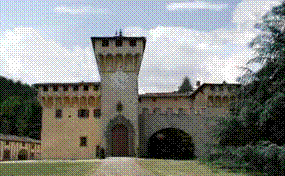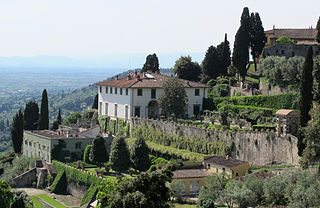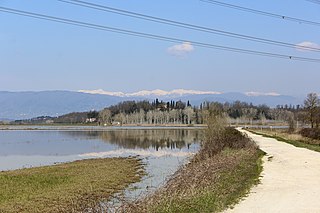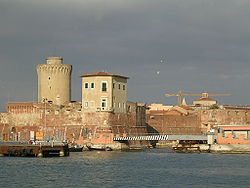
The House of Medici was an Italian banking family and political dynasty that first consolidated power in the Republic of Florence under Cosimo de' Medici and his son Lorenzo "the Magnificent" during the first half of the 15th century. The family originated in the Mugello region of Tuscany, and prospered gradually in trade until it was able to fund the Medici Bank. This bank was the largest in Europe in the 1400s and facilitated the Medicis' rise to political power in Florence, although they officially remained citizens rather than monarchs until the 16th century.

Livorno is a port city on the Ligurian Sea on the western coast of the Tuscany region, Italy. It is the capital of the Province of Livorno, having a population of 158,493 residents in December 2017. It is traditionally known in English as Leghorn.

Volterra is a walled mountaintop town in the Tuscany region of Italy. Its history dates from before the 8th century BC and it has substantial structures from the Etruscan, Roman, and Medieval periods.

The Grand Duchy of Tuscany was an Italian monarchy that existed, with interruptions, from 1569 to 1860, replacing the Republic of Florence. The grand duchy's capital was Florence. In the 19th century the population of the Grand Duchy was about 1,815,000 inhabitants.

Grosseto is a comune in the central Italian region of Tuscany, the capital of the province of Grosseto and of the Maremma. The city lies 14 kilometres from the Tyrrhenian Sea, at the centre of an alluvial plain on the Ombrone river.

Ferdinando II de' Medici was grand duke of Tuscany from 1621 to 1670. He was the eldest son of Cosimo II de' Medici and Maria Maddalena of Austria. Remembered by his contemporaries as a man of culture and science, he actively participated in the Accademia del Cimento, the first official scientific society in Italy, formed by his younger brother, Leopoldo de' Medici. His 49-year rule was punctuated by the beginning of Tuscany's long economic decline, which was further exacerbated by his successor, Cosimo III de' Medici. He married Vittoria della Rovere, a first cousin, with whom he had two children who reached adulthood: the aforementioned Cosimo III, and Francesco Maria de' Medici, Duke of Rovere and Montefeltro, a cardinal.
The Accademia del Cimento, an early scientific society, was founded in Florence in 1657 by students of Galileo, Giovanni Alfonso Borelli and Vincenzo Viviani and ceased to exist about a decade later. The foundation of Academy was funded by Prince Leopoldo and Grand Duke Ferdinando II de' Medici. The tenets of the society included:

A bastion fort or trace italienne is a fortification in a style that evolved during the early modern period of gunpowder when the cannon came to dominate the battlefield. It was first seen in the mid-fifteenth century in Italy. Some types, especially when combined with ravelins and other outworks, resembled the related star fort of the same era.

The Villa Medicea di Cafaggiolo is a villa situated near the Tuscan town of Barberino di Mugello in the valley of the River Sieve, some 25 kilometres north of Florence, central Italy. It was one of the oldest and most favoured of the Medici family estates, having been in the possession of the family since the 14th century, when it was owned by Averardo de' Medici. Averardo's son, Giovanni di Bicci de' Medici, is considered to be the founder of the Medici dynasty.

The Medici villas are a series of rural building complexes in Tuscany which were owned by members of the Medici family between the 15th century and the 17th century. The villas served several functions: they were the country palaces of the Medici, scattered over the territory that they ruled, demonstrating their power and wealth. They were also recreational resorts for the leisure and pleasure of their owners; and, more prosaically, they were the centre of agricultural activities on the surrounding estates. In 2013, the Medici villas were added to UNESCO's World Heritage list.

The Fortezza is the citadel of the city of Rethymno in Crete, Greece. It was built by the Venetians in the 16th century, and was captured by the Ottomans in 1646. By the early 20th century, many houses were built within the citadel. These were demolished after World War II, leaving only a few historic buildings within the Fortezza. Today, the citadel is in good condition and is open to the public.

The Port of Livorno is one of the largest Italian seaports and one of the largest seaports in the Mediterranean Sea, with an annual traffic capacity of around 30 million tonnes of cargo and 700,000 TEU's.

Lago di Bientina, also known as Lago di Sesto, was a lake in Tuscany, Italy. Located to the north of the town of Bientina, between Lucca and Pisa, the lake was historically subject to numerous efforts at drainage due to its tendency to flood. Early attempts at canal-building and drainage in the 16th century were hampered by the lake's connection with the Arno River, which often led to backflow and even increased flooding.

The Cittadella Nuova, now called the Giardino di Scotto or Giardino Scotto is an old fortress in Pisa.

During World War II, Tuscany, the Italian port city of Livorno was repeatedly bombed by the Allied air forces, suffering about a hundred raids altogether, which resulted in it being among the most war-damaged cities in Italy.

The Walls of Grosseto, known also as Medicean Walls, are a series of defensive brick walls surrounding the city of Grosseto in Tuscany, Italy.

The fortezza Firmafede, also named La Cittadella or Fortezza di Sarzana, is a military fortification in Sarzana, in the Province of La Spezia, Liguria, Italy.

The fortress of Sarzanello is a military fortification on the Sarzanello hill, near Sarzana, in province of La Spezia, Italy, above the Val di Magra. Since December 2014 it is managed by the Ministry of Culture.
16.^Silvia Guagliumi, Antonio da San Gallo il Vecchio, ISBN 979-12-210-6439-1, Milano, Giugno 2024.



















